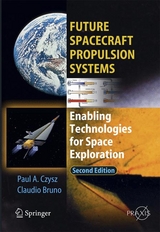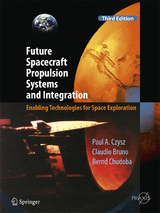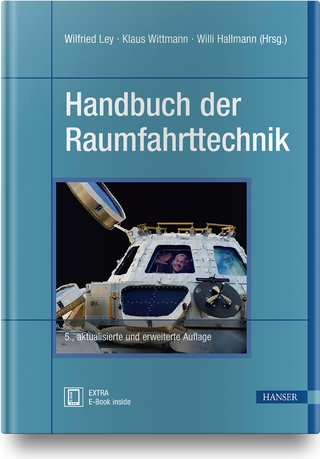Future Spacecraft Propulsion Systems
Enabling Technologies for Space Exploration
Seiten
2009
|
2nd ed. 2009
Springer Berlin (Verlag)
978-3-540-88813-0 (ISBN)
Springer Berlin (Verlag)
978-3-540-88813-0 (ISBN)
- Titel erscheint in neuer Auflage
- Artikel merken
Zu diesem Artikel existiert eine Nachauflage
Commercial Proximate Earth Launcher.- On-orbit Operations in Proximate Earth Orbit.- Earth-Moon System Advantages.- The Need for Nuclear or High Energy Space Propulsion.- The Need for Very High Energy Space Propulsion.- The Need for Light Speed Plus Propulsion.
In this second edition of Future Spacecraft Propulsion Systems, the authors demonstrate the need to break free from the old established concepts of expendable rockets, using chemical propulsion, and to develop new breeds of launch vehicle capable of both launching payloads into orbit at a dramatically reduced cost and for sustained operations in low-Earth orbit. The next steps to establishing a permanent presence in the Solar System beyond Earth are the commercialisation of sustained operations on the Moon and the development of advanced nuclear or high-energy space propulsion systems for Solar System exploration out to the boundary of interstellar space.In the future, high-energy particle research facilities may one day yield a very high-energy propulsion system that will take us to the nearby stars, or even beyond. Space is not quiet: it is a continuous series of nuclear explosions that provide the material for new star systems to form and provide the challenge to explore. This book provides an assessment of the industrial capability required to construct and operate the necessary spacecraft. Time and distance communication and control limitations impose robotic constraints. Space environments restrict human sustained presence and put high demands on electronic, control and materials systems. This comprehensive and authoritative book puts spacecraft propulsion systems in perspective, from earth orbit launchers to astronomical/space exploration vehicles. It includes new material on fusion propulsion, new figures and updates and expands the information given in the first edition.
In this second edition of Future Spacecraft Propulsion Systems, the authors demonstrate the need to break free from the old established concepts of expendable rockets, using chemical propulsion, and to develop new breeds of launch vehicle capable of both launching payloads into orbit at a dramatically reduced cost and for sustained operations in low-Earth orbit. The next steps to establishing a permanent presence in the Solar System beyond Earth are the commercialisation of sustained operations on the Moon and the development of advanced nuclear or high-energy space propulsion systems for Solar System exploration out to the boundary of interstellar space.In the future, high-energy particle research facilities may one day yield a very high-energy propulsion system that will take us to the nearby stars, or even beyond. Space is not quiet: it is a continuous series of nuclear explosions that provide the material for new star systems to form and provide the challenge to explore. This book provides an assessment of the industrial capability required to construct and operate the necessary spacecraft. Time and distance communication and control limitations impose robotic constraints. Space environments restrict human sustained presence and put high demands on electronic, control and materials systems. This comprehensive and authoritative book puts spacecraft propulsion systems in perspective, from earth orbit launchers to astronomical/space exploration vehicles. It includes new material on fusion propulsion, new figures and updates and expands the information given in the first edition.
Overview.- Our progress appears to be impeded.- Commercial near-Earth space launcher: a perspective.- Commercial near-Earth launcher: propulsion.- Earth orbit on-orbit operations in near-Earth orbit, a necessary second step.- Earth-Moon system: establishing a Solar System presence.- Exploration of our Solar System.- Stellar and interstellar precursor missions.- View to the future and exploration of our Galaxy.
| Reihe/Serie | Astronautical Engineering | Springer Praxis Books |
|---|---|
| Zusatzinfo | XXIV, 560 p. |
| Verlagsort | Berlin |
| Sprache | englisch |
| Maße | 170 x 242 mm |
| Gewicht | 1266 g |
| Themenwelt | Technik ► Luft- / Raumfahrttechnik |
| Schlagworte | Control • Electric rockets explained • IAC • Propulsion space • Raketenantrieb • Raumfahrt • Spacecraft engines |
| ISBN-10 | 3-540-88813-6 / 3540888136 |
| ISBN-13 | 978-3-540-88813-0 / 9783540888130 |
| Zustand | Neuware |
| Haben Sie eine Frage zum Produkt? |
Mehr entdecken
aus dem Bereich
aus dem Bereich
Grundlagen, Mathematik, Kartenkunde, leistungsbasierte Navigation
Buch | Softcover (2022)
De Gruyter Oldenbourg (Verlag)
72,95 €
Das aktuelle Raumfahrt-Jahrbuch mit allen Starts
Buch | Softcover (2022)
Verein zur Förderung der Raumfahrt e.V. (Verlag)
18,90 €





